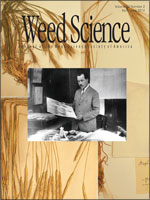In a previous study, glyphosate-susceptible and -resistant giant ragweed biotypes grown in sterile field soil survived a higher rate of glyphosate than those grown in unsterile field soil, and the roots of the susceptible biotype were colonized by a larger number of soil microorganisms than those of the resistant biotype when treated with 1.6 kg ae ha−1 glyphosate. Thus, we concluded that soil-borne microbes play a role in glyphosate activity and now hypothesize that the ability of the resistant biotype to tolerate glyphosate may involve microbial interactions in the rhizosphere. The objective of this study was to evaluate differences in the rhizosphere microbial communities of glyphosate-susceptible and -resistant giant ragweed biotypes 3 d after a glyphosate treatment. Giant ragweed biotypes were grown in the greenhouse in unsterile field soil and glyphosate was applied at either 0 or 1.6 kg ha−1. Rhizosphere soil was sampled 3 d after the glyphosate treatment, and DNA was extracted, purified, and sequenced with the use of Illumina Genome Analyzer next-generation sequencing. The taxonomic distribution of the microbial community, diversity, genera abundance, and community structure within the rhizosphere of the two giant ragweed biotypes in response to a glyphosate application was evaluated by metagenomics analysis. Bacteria comprised approximately 96% of the total microbial community in both biotypes, and differences in the distribution of some microbes at the phyla level were observed. Select soil-borne plant pathogens (Verticillium and Xanthomonas) and plant-growth–promoting rhizobacteria (Burkholderia) present in the rhizosphere were influenced by either biotype or glyphosate application. We did not, however, observe large differences in the diversity or structure of soil microbial communities among our treatments. The results of this study indicate that challenging giant ragweed biotypes with glyphosate causes perturbations in rhizosphere microbial communities and that the perturbations differ between the susceptible and resistant biotypes. However, biological relevance of the rhizosphere microbial community data that we obtained by next-generation sequencing remains unclear.
Nomenclature: Glyphosate; giant ragweed, Ambrosia trifida L.





